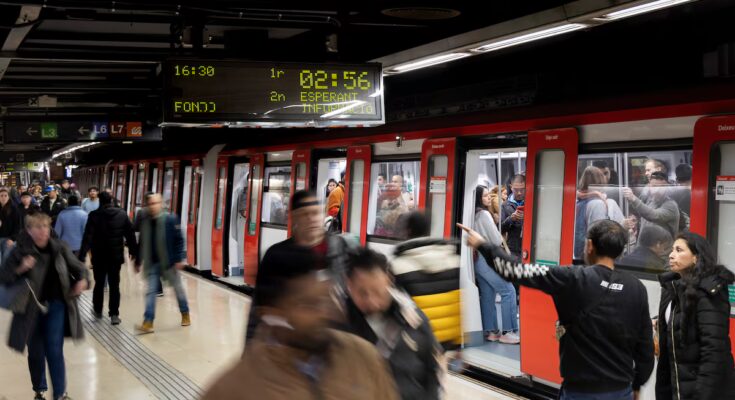The Metropolitan Transport Authority (ATM) – the consortium formed by The Generalitat, the City of Barcelona, the Metropolitan Area of Barcelona and the Association of Municipalities for Mobility and Urban Transport, which manages public transport fares and timetables, have already come to a conclusion that will impose changes: “the rush hour of transport in Barcelona is moved forward”. Teleworking and work flexibility have led citizens to go to work earlier and also to return home earlier. All this will force us to modify transport services in the coming months, after the pandemic has opened up the possibility of totally or partially modifying our presence in the workplace.
This Friday, the ATM published a statement admitting the change in mobility behavior of citizens. In this case, they warned that Trambaix suffers from unprecedented demand every Friday at 3pm. This demand has already forced an increase in frequencies at this time. A spokeswoman for the transport consortium admits that, post-Covid, mobility patterns in public transport have been disrupted. “We have observed a very significant increase in demand in the old off-peak hours, especially in the afternoon,” says ATM, admitting that mobility has become “different and complex”. The ATM found that public transport has fewer users on Mondays and Fridays, when people prefer to telework.
The CEO of Barcelona Metropolitan Transport (TMB), Xavier Flores, warns that not only has teleworking changed citizens’ behaviour. Previously the T10 (the single ticket for 10 journeys) was the most used ticket both on the subway and on the bus. Today TCasual (as it was renamed, in 2020, T10) is used by only 10% of users when it was managed by 42%. Currently, stocks that provide a flat fee have gained a lot of weight. Refers to subscriptions like TUsual or TJove that allow unlimited use over a period of time (month or quarter). In 2019 these flat rate titles were used by 24.6% of users and today 67.7% do so. Flores argues that holders of these titles make extensive use of public transport, which – together with telecommuting and, above all, work flexibility – represents a modification of the concept of rush hour. “Before the pandemic, the peak time was from 8:00 to 9:00. Since 2019, the number of users in that period has increased by 5.6%. But from 7:00 to 8:00 it has grown by 13% and from 6:00 to 7:00 by 35%,” explains the CEO of TMB. It’s clear that telecommuting and flexibility, along with discounted flat-rate securities, have changed user behavior. “Today there are many working days in which we exceed 1,600,000 validations. In 2019 there were only two days in which we exceeded 1,500,000. We know that Monday is a slow day, we understand this because of teleworking. Our peak hours are from 8:00 to 9:00, then it drops to 1:00 p.m., at 2:00 p.m. it drops again to 5:00 p.m. On Friday mornings there is less mobility, but in the afternoon and evening you notice that people use the subway to go to places of leisure,” concludes Flores. Buses exceed 800,000 validations on weekdays. “The bus is the gateway to public transportation for children. The peak time is when they get out of school, between 5pm and 6pm,” says Flores.
The director of operations of Ferrocarrils de la Generalitat de Catalunya, Oriol Juncadella, confirms the changes in user behavior. “The pandemic has led many people to live outside of Barcelona in search of greener areas and, at the same time, many companies have left the city. Our traditional peak hour is from 7.30 to 9.30. From 7.00 to 8.00 the peak time has not moved much relative to demand, but from 6.00 to 7.00 it has. In the afternoon, Monday to Thursday there is a peak hour from 2.00 to 3pm and another from 6pm to 7pm. Of course, on Fridays the peak period doesn’t exist,” he concludes. Juncadella assures that also – in relation to teleworking – there are peak days which are “Tuesday, Wednesday and Thursday”. Ferrocarriles de la Generalitat (with 104 trains and two lines: Vallès and Llobregat-Anoia) will close this year with 100 million validations (Rodalies carries out 130 million). At peak hours, the line between the Catalan capital and Vallès carries 30,000 passengers per hour and the Llobregat-Anoia line carries 11,000 users. “There are 20% more passengers than in 2019,” he remarks. “People go to work earlier. The occupancy level of trains has increased a little but we are not in a collapse situation. The peaks are anticipated and grow moderately. When demand increases further it will not be necessary to buy more trains but rather increase the offer throughout the day with more operating expenses and more drivers. We are studying and believe that this change will be made within a year”, concludes the operations director.
The situation of Renfe’s Rodalies is much worse. In crisis due to underfunding and the concentration of ADIF’s works, making a calculation on user behavior is complicated. And it is even more so if we take into account that accidents are continuous and that everyone could have looked for alternatives to this type of transport. Nonetheless, a spokesperson assures that “Renfe monitors demand behavior to adapt it to travellers’ needs and new trends”. Changes that are often adapted to holiday periods and sporting events. In Renfe the rush hour is from 7:00 to 9:00 and from 18:00 to 18:00. to 7:00 pm The time of arrival at work or home (whether morning or afternoon) is always unpredictable.



